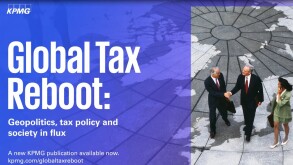Tax leaders and their organisations continue to work through potential implications of the GloBE Model Rules, following the 14 March Inclusive Framework release or a 228-page Commentary, supplemented by an OECD Secretariat document containing 24 examples, including structural diagrams and tables highlighting key features of the rules.
A full KPMG International analysis of the document is available here. Below, are a selection of questions and answers about the Commentary based on queries received to date.
1. What is said about the consistency of the rules?
2. What does the Commentary say on how the revenue threshold of €750 million is determined?
3. Can an IIR apply to companies in the same jurisdiction as the IIR entity?
4. Is it true that top-up tax can be paid in respect of a jurisdiction with a loss?
5. Will the basis step-up and deferred taxes associated with asset transfers taking place during the implementation period be disregarded?
6. How are taxes paid under pillar one treated?
The Commentary also explicitly excludes digital services taxes from the definition of covered taxes.
7. What is a Partially Owned Parent Entity (POPE)? And what if a POPE owns another POPE?
8. What measures can a country take to apply the UTPR?
9. What other points are made in the Commentary about UTPRs?
10. What do you need to be able to say a jurisdiction has a qualified IIR?
11. How are income and expenses treated when they do not go through the P&L but are included in other comprehensive income (OCI) for determining GloBE income or loss?
12. Who determines whether a deviation from the UPE’s accounting standard in respect of an item included in the Constituent Entity’s Financial Accounting Net Income is minor and inconsequential and below a materiality threshold?
The financial auditor’s acceptance of a deviation without qualification is ‘good evidence’ that a deviation is immaterial. If the accounts are qualified it is relevant, but not conclusive, evidence that the deviation is material.
13. Excluded dividends are not included in GloBE income or loss. What about expenses directly related to the derivation of those excluded dividends? What about excluded equity gains and losses?
Although some tax regimes link such expense to the derivation of exempt income in connection with a participation exemption, the GloBE rules do not. The Commentary states this is for simplicity. Some tax regimes link currency hedge gains and losses to the underlying equity interest. The Commentary states that consideration of a similar rule will be considered in the implementation consultation.
14. Can a stock-based compensation election to follow the tax treatment rather than the accounting treatment apply to non-employees?
Yes. It can apply to non-employees. The tax treatment will follow the local taxation rules. The stock-based election must be undertaken on a jurisdiction-by-jurisdiction basis as is for five years.
15. Must GloBE income or loss be adjusted for the arm’s-length principle?
Broadly, yes, for cross border transactions, except in very limited circumstances where it gives rise to double taxation or double non-taxation. Broadly, no adjustments are required for same country transactions except where a sale or other transfer gives rise to a loss. However, Constituent Entities and Minority Sub-groups in the same jurisdiction are required to apply the Arm’s Length Principle.
16. Does deferred tax operate on an aggregated or an item-by-item basis?
Deferred Tax Adjustments can be recorded on an item-by-item basis or an aggregated basis provided it is at the same deferred tax rate. Note that deferred tax liabilities must be monitored on an item-by-item basis to determine if the 5-year reversal requirement is satisfied, unless covered by the recapture exception. This may present practical difficulties for many organisations.
17. Can one obtain a refund for prior year adjustments and loss carrybacks under GloBE rules?
No. The adjustments are made in the redetermination year or the year of recognition for losses and one does not recalculate prior years to obtain a refund.
18. Can the substance-based income exclusion of one entity be used to reduce the excess profit of another entity?
Yes, if they are in the same jurisdiction and subject to the same blending. Substance based Income Exclusion is calculated on a jurisdiction-by-jurisdiction basis.
19. How does one determine payroll and tangible assets where employees or assets work or are used in more than one jurisdiction under the substance-based income exclusion?
The Commentary states that guidance will be developed to assist in administrative simplicity.
20. What does the Commentary leave ambiguous?
While the Commentary provides further gloss on the framework under which a tax administration could challenge the use of a GloBE safe harbour, such as how a jurisdiction could show it is ‘affected’ by use of the safe harbour, the specifics of the safe harbours are still to be set out under the GloBE Implementation Framework. It remains to be seen how a safe harbour based (say) on CBCR data (as earlier proposed) would deal with GloBE tax imposed when a jurisdictional ETR is above 15%, e.g., where 4.1.5 applies to impose additional current top up tax.
The Commentary does not provide a conclusive answer to when an MNE might be deemed to exist. The definition of consolidated financial statements in the rules indicated that collections of entities under common control could be obliged to prepare consolidated financial statements, where they do not already do so, and be subject to GloBE taxation as a group. The Commentary does not go further in explaining the circumstances in which this might apply.
While the Commentary provides some guidance on how taxes are to be allocated in the case of PEs and CFCs, it also acknowledges that more detailed rules will be needed for specific country tax regimes. A common methodology for allocation of such taxes will be developed under the GloBE Implementation Framework. As such, for the moment it cannot be definitively said how such allocations will be performed to arrive at precise ETR estimates.
In connection with the substance-based income exclusion, the Commentary acknowledges that further work will be needed in relation to staff working for an MNE in multiple jurisdictions, as well as assets used in multiple jurisdictions. This is also anticipated under the GloBE Implementation Framework.
The Commentary provides some detail on what will be required to be reported in the GloBE Information Return. However, the specifics await further work under the GloBE Implementation Framework.
While the rules provide for the use of deferred tax attributes existing at the beginning of the transition year, open issues remain on how they can be recognised, e.g., the meaning of ‘reflected or disclosed’ in the financial accounts. Agreed administrative guidance is to be developed under the GloBE Implementation Framework.
The operation of the rules turns on whether IIRs, UTPRs, and domestic minimum taxes, put in place by jurisdictions, are recognised as ‘qualified’. While the Commentary does provide some clarity, such as on the types of potential benefits to constituent entities which could lead to disqualification, full clarity is awaited under the GloBE Implementation Framework.





































